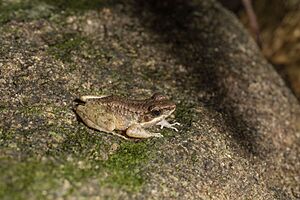Odorrana utsunomiyaorum facts for kids
Quick facts for kids Odorrana utsunomiyaorum |
|
|---|---|
 |
|
| Conservation status | |
| Scientific classification | |
| Synonyms | |
|
Rana utsunomiyaorum Matsui, 1994 |
The Odorrana utsunomiyaorum is a special kind of frog. It belongs to the family called Ranidae, also known as "true frogs." This frog lives only in the Ryukyu Archipelago in Japan. You can find it on two islands: Ishigaki and Iriomote. These islands are part of the Yaeyama Group. The frog's name, utsunomiyaorum, honors two people, Taeko and Yasuaki Utsunomiya. They helped us learn a lot about the amphibians (like frogs and salamanders) living in the Yaeyama Group.
Contents
What Does the Frog Look Like?
These frogs are not very big. Adult male frogs are about 39–48 mm (1.5–1.9 in) long. Adult female frogs are a bit larger, measuring about 46–59 mm (1.8–2.3 in) long. This measurement is taken from their snout (nose) to their vent (where waste leaves the body).
The Odorrana utsunomiyaorum has a body that is fairly strong and a head shaped like a triangle. Its snout looks a bit pointed from above, but rounded when you look at it from the side.
Special Features of the Frog
- Ears: It has clear "ears" called a tympanum. This is a round patch behind its eye that helps it hear.
- Fingers and Toes: Its fingers do not have webs between them. They have small, flat pads called discs at the tips. Its toes, however, have good webbing, which helps it swim. The discs on its toes are a little smaller than those on its outer fingers.
- Skin: The frog's back is covered with many small bumps, called tubercles. It has a slightly raised fold of skin along its sides, but no fold above its ear drum.
- Color: The color of its back can be light brown or greenish-brown. It often has some dark spots or blotches. There are also dark marks below its eyes, around its ear drums, and along the folds on its sides. Its legs have dark, broken stripes.
- Male Frogs: Male frogs have two vocal sacs under their throat. These sacs inflate when they call out to attract mates.
Dwarf vs. Giant Frogs
On both Ishigaki and Iriomote islands, the Odorrana utsunomiyaorum lives alongside another frog species called Odorrana supranarina. The O. supranarina is a much larger frog. Because O. utsunomiyaorum is a "dwarf" (small) species and O. supranarina is a "giant" (large) species, scientists think their sizes changed over time. This might have happened because they were competing for food or space.
Where the Frog Lives and How We Protect It
The Odorrana utsunomiyaorum lives in broad-leaved evergreen forests. These forests are usually found along mountain streams. If the larger Odorrana supranarina is also present, the O. utsunomiyaorum tends to live in smaller streams.
Reproduction and Life Cycle
These frogs lay their eggs in shallow streams. Breeding happens from late February to April. The female frog attaches her eggs to stones that are under the water.
Protecting the Odorrana utsunomiyaorum
This frog species lives in a small area, and its habitat is broken up into smaller pieces. The biggest danger to these frogs is when their homes are destroyed or damaged. This often happens because of deforestation, which is when forests are cut down.
Iriomote Island is part of a national park. Even though it's a national park, more effort is needed to protect its forest habitats. The frogs also face a problem from an animal that was brought to the islands by humans: the cane toad (Rhinella marina). These cane toads compete with the native frogs for food and space.


